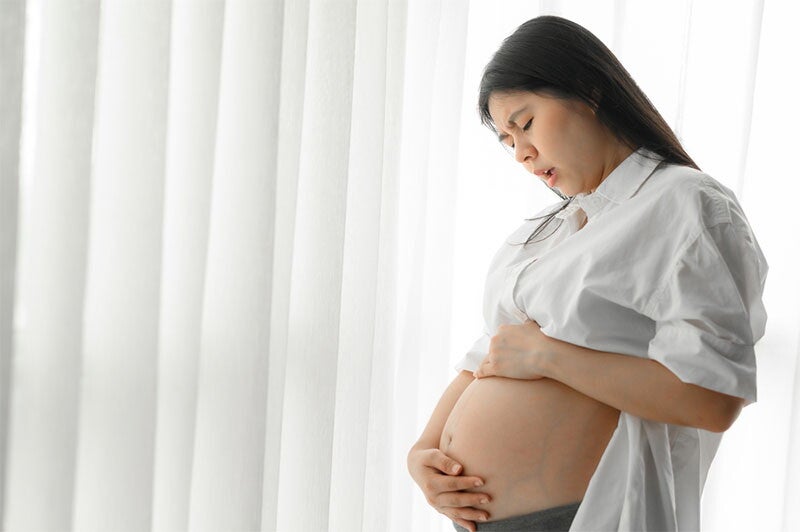
As you eagerly await your baby's arrival, you might be wondering what giving birth is actually like. Learning about the 4 stages of labor not only gives you an idea of what to expect but can also ease any nerves you might have and help you feel more prepared for delivery. Read this guide to turn your worry into confidence for an incredible birth experience.
First Stage: Early and Active Labor
The first stage of labor typically takes the longest and has two main phases: early labor and active labor, ending in the transition phase.
Early labor
During early labor, your cervix begins to soften and open (dilate) from 0 up to about 6 cm. You may feel the start of contractions as strong menstrual cramps or abdominal and lower back tightening. They might be mild, irregular, and spaced far apart (perhaps every 15 to 20 minutes, each lasting 30 to 60 seconds).
Active Labor
As you move into active labor, things intensify. Your cervix will dilate from 6 to 10 cm. Contractions become stronger, longer (around 45 to 70 seconds), and more frequent (every three to five minutes). You might find it harder to talk through contractions and will need to focus more on coping strategies.
You may also notice your "bloody show" (loss of the mucus plug tinged with blood) if you haven't already, and your water might break—this can be a gush or a trickle of amniotic fluid.
Transition
The transition phase is the tail-end of active labor, where your cervix dilates to about 8 to 10 cm. It’s often the most intense and challenging part of labor, but thankfully, it's usually the shortest. Contractions are very strong, long (60 to 90 seconds), and close together (every two to three minutes).
Second Stage: Pushing and Birth

Breathing techniques can help you cope with strong contractions.
The second stage of labor, or the pushing stage, begins once your cervix is fully dilated to 10 cm and ends with your baby’s birth. Contractions may feel different now, typically lasting 60 to 90 seconds and coming every three to five minutes.
You'll feel an overwhelming urge to bear down with each contraction. This stage can last a few minutes to several hours, especially for first-time mothers or those with an epidural.
When your baby is born, your doctor will gently clear their mouth and nose, and the umbilical cord will be clamped and cut.
Third Stage: Delivery of the Placenta
After your baby is born, you’ll continue to have mild contractions, which help the placenta detach from the uterine wall. This is the third stage of labor, typically lasting from five to 30 minutes.
Your doctor will examine the placenta to ensure it’s intact and that no fragments remain behind, which is essential for preventing complications.
Fourth Stage: Recovery Period
The immediate postpartum recovery period is the fourth stage of labor, typically lasting one to four hours after you deliver the placenta. Your healthcare team will monitor you closely during this time, checking your blood pressure, pulse, and vaginal bleeding (lochia). They may also massage your uterus (fundal massage) to help it contract and reduce bleeding.
Your healthcare team will also make sure you have skin-to-skin contact with your baby, as part of the Department of Health’s (DOH) Unang Yakap protocol. This closeness helps regulate your newborn's temperature, heart rate, and breathing, according to UNICEF. The World Health Organization (WHO) also champions these practices to promote early breastfeeding.
How Long Does Each Stage of Labor Last?
The duration of each stage varies for everyone, but there are some general timeframes:
- First stage: The early labor phase can range from several hours to over a day. Active labor might last four to eight hours.
- Second stage: For first-time moms, this can be half an hour to two hours (sometimes longer with an epidural). For subsequent births, it can be as short as a few minutes to an hour.
- Third stage: This phase typically lasts from five to 30 minutes.
- Fourth stage: Healthcare providers will monitor you closely for one to four hours after delivery.
Several factors influence how long your labor will be, such as:
- If it's your first baby or a subsequent birth
- Baby's position and size
- The intensity of your contractions
- Pain relief medication
- Your birthing environment and support
Natural pain management options
Now that you have a better sense of how long each stage can last, you can explore how to manage pain and stay comfortable throughout labor. Natural pain relief methods can be used alone or in combination with medical pain relief.
1. Breathing techniques
Focused breathing techniques can help you stay calm, centered, and in control during contractions while also ensuring a good oxygen supply for you and your baby. But for some, breathing alone may not be enough for very intense pain.
2. Movement and positioning
Walking, swaying, and rocking can significantly help your labor progress, ease discomfort, and encourage your baby into an optimal position for birth. Additionally, a 2023 review published in the journal Cureus supports the benefits of using various positions during labor and birth, such as standing, sitting, or squatting.
However, your ability to move freely might be limited if you have certain medical interventions.
3. Massage and counterpressure
The American Pregnancy Association notes that massage and counterpressure (applying firm, steady pressure to areas like your lower back) can help relieve muscle tension and make you feel more comfortable. This is also a great way to involve your birth partner. However, the relief you get from this method is different for everyone.
4. Hydrotherapy
Relaxing in a warm tub or shower can be very soothing during labor. A 2024 systematic review on the use of hydrotherapy in labor found that it could help reduce your perception of pain and increase comfort.
However, water immersion isn't always available or suitable for every situation, for example, if your water has been broken for an extended period or if you require continuous electronic monitoring.
5. Relaxation techniques
A 2022 study published in BMC Pregnancy and Childbirth found that learning relaxation techniques and skilled breathing (like deep breathing), especially in classes you take during pregnancy, can help you feel less anxious or scared about childbirth. While these methods might not reduce pain in the exact same way for everyone, relaxation is still a fantastic tool to help you through labor.
Medical Pain Relief Options

Pain relief options for labor can vary; choose from breathing and movement to medical options.
Depending on your condition, healthcare professionals may administer one of these options for labor pain:
- Epidural anesthesia
- Spinal block
- Nitrous oxide
- Opioids
Now that you understand the 4 stages of labor and what to expect during each phase, you can approach childbirth with more confidence and peace of mind. Remember, your healthcare team is there to support you every step of the way.
Experiencing the 4 stages of labor is unique for every parent. Join the ParentTeam Moms and Dads Facebook group to share experiences, ask questions, and find support.
References
American Pregnancy Association. "Relaxation Techniques For Labor." American Pregnancy Association. Accessed June 2, 2025. https://americanpregnancy.org/healthy-pregnancy/labor-and-birth/relaxation-techniques/.
Cleveland Clinic. "Explore Your Options: Labor and Birthing Positions To Consider." Cleveland Clinic. Published May 7, 2024. Accessed June 2, 2025. https://health.clevelandclinic.org/labor-positions.
Cleveland Clinic. "Stages of Labor." Cleveland Clinic. Last reviewed April 23, 2025. Accessed June 2, 2025. https://my.clevelandclinic.org/health/body/22640-stages-of-labor.
Hutchison, James, Mahalah V. A. Mahdy, and Jason Hutchison. "Physiology, Normal Labor and Delivery." In StatPearls. Treasure Island, FL: StatPearls Publishing, 2025. Last updated February 15, 2025. Accessed June 2, 2025. https://www.ncbi.nlm.nih.gov/books/NBK544290/.
Newton-Wellesley Hospital. "Comfort Measures During Labor & Delivery: Non-Pharmacologic Methods." Mass General Brigham. Accessed June 2, 2025. https://www.nwh.org/patient-guides-and-forms/maternity-guide/maternity-chapter-3/comfort-measures-during-labor-and-delivery-non-pharmacological-methods.
NHS. "The stages of labour and birth." NHS. Last reviewed May 2, 2023. Accessed June 2, 2025. https://www.nhs.uk/pregnancy/labour-and-birth/what-happens/the-stages-of-labour-and-birth/.
Pregnancybirth&baby. "Positions for labour and birth." Healthdirect Australia. Last reviewed June 2024. Accessed June 2, 2025. https://www.pregnancybirthbaby.org.au/positions-for-labour-and-birth.
Queensland Government. "The fourth stage." Queensland Government. Last updated May 18, 2020. Accessed June 3, 2025. https://www.qld.gov.au/health/children/pregnancy/antenatal-information/stages-of-labour/the-fourth-stage.
Smith, Caroline A., Kate M. Levett, Carmel T. Collins, Mike Armour, Hannah G. Dahlen, and Masayo Suganuma. "Relaxation techniques for pain management in labour." Cochrane Database of Systematic Reviews 3, no. 3 (2018): CD009514. Accessed June 2, 2025. https://doi.org/10.1002/14651858.CD009514.pub2.
UNICEF UK. "Research on Skin-to-skin contact." The Baby Friendly Initiative. Accessed June 2, 2025. https://www.unicef.org.uk/babyfriendly/news-and-research/baby-friendly-research/research-supporting-breastfeeding/skin-to-skin-contact/.









